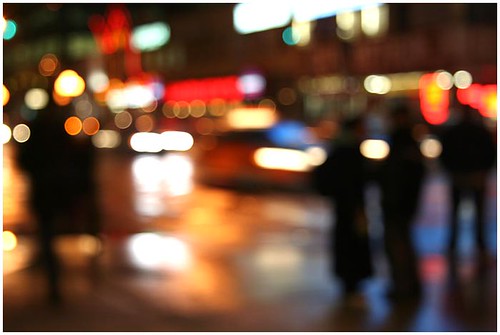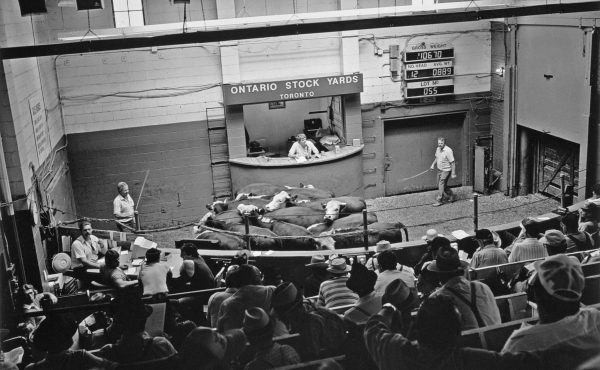
Sorry for the Toronto Sun-like headline, but I couldn’t resist. But who knew that the likeihood of a pedestrian being struck within the first few weeks of standard time increased by a whopping 186%? Two Carnegie Mellon University scientists conducted a study from 1999-2005 that concludes pedestrians and drivers are slow to adapt to earlier darkness.
From the Pittsburgh Post-Gazette:
Professors Paul Fischbeck and David Gerard have made a study of traffic fatalities that shows pedestrians walking during the evening rush hour are nearly three times more likely to be struck and killed by cars in the weeks after the fall time change.
The problem, they suspect, is that pedestrians and drivers have gotten used to more than six months of visibility during those hours and are slow to adapt to the danger of the darkness.
“The change that’s going to occur on Sunday is going to have some pronounced effects on your risks of walking between 5 p.m. and 7 p.m.,” Dr. Gerard said last night. “Basically, these are the hours when it’s just getting dark. Next week at this time, it will be pitch black. But people walking and people driving won’t have adjusted. The baseline risk for getting killed is almost tripled.”
Their study of pedestrian fatalities from 1999-2005 shows that there is an average of 37 more U.S. pedestrian deaths around 6 p.m. in November compared to October. That amounts to an increase of 186 percent.
No such jump was seen for drivers or passengers in cars.
“It’s astonishing,” Dr. Gerard said of the data. “It’s particularly worse right at the switch date, [when the average increases] two people a day for the next couple weeks, until the adjustment is made.”
…
“There’s no significant difference at noon, but there is at 6 p.m.,” Dr. Gerard said. After spiking sharply in November, the number of pedestrian deaths at 6 p.m. begins to drop in December. The danger declines each month. Once everyone “springs forward” to daylight-saving time in April, there is a 78 percent drop in risk at 6 p.m., they said.
The risk at 6 p.m. in November, after daylight-saving time ends, is 11 times higher than the risk for the same hour in April, when daylight-saving begins, according to the Carnegie Mellon researchers.
A 2001 study by John M. Sullivan at the University of Michigan looked at national traffic statistics from 1987 to 1997 and found that there were 65 crashes killing pedestrians in the week before the clocks fell back and 227 in the week after.
But overall for the evening rush hour, turning the clock back is a killer. In seven years there have been 250 more deaths in the fall and 139 fewer deaths in the spring.
Photo by Sean Connors




7 comments
Don’t forget the bicycles.They are no longer rquired to have lights on their bikes so they are hard to spot. Little is reported of pedestrians being struck by bikes in this city after dark as well.
A great parody of a Sun headline, because like many of theirs it’s misleading! As the article notes, daylight saving time ends in November. Is it actually standard time that’s the killer?
The UK tried year-round DST from 1968-1971; apparently accidental deaths dropped by 2,500 over two years.
Since Saskatchewan is on year-round standard time, it’s too bad the study didn’t look at accident rates there to see how much of the problem is caused by the changeover itself versus earlier sunsets.
George, cyclists are required to have a headlight on the front, and a red reflector or light on back. I’m not sure how it’s relevant though, since the study is about fatalities, and a much better explanation is that car drivers have trouble seeing pedestrians on these dark and probably wet evenings.
Hey George,
Get real. I am not saying bicycles never injure anyone but hardly a fair to accuse them of being
responsible for the CARnage on Toronto roads.
Btw, this just in:
Pedestrian struck, dragged
Tuesday, November 06, 2007 – 10:04 AM
By: 680News staff
Toronto – A pedestrian has been struck by a vehicle north of Warden and Lawrence Aves.
The pedestrian, a woman believed to be in her 40s, was hit by a Dodge Durango and dragged about 30 metres, police said. She’s being treated at Sunnybrook Hospital for serious head injuries.
The studies also need to bring in the other side of this coin – what is the increase in pedestrian injuries and other traffic fatalities when the clocks go forward in March and it’s pitch dark again in the morning after everyone started getting used to the light?
Also with the later switch back to Standard Time, the darkness arrives earlier in the day than it used to. If sunset is about 2-3 minutes earlier each day, then by shifting the Standard Time switch back a week, the darkness arrives about 15-20 minutes earlier than it would have been had the switch occurred last week. Sunset today is at 5:03PM, so on Sunday it would have been about 5:08PM. If the switch to Standard Time had been a week sooner, the “early” sunset would have been at about 5:26PM. I’m not sure how much difference this would make to fatalities, but later the switch is, the earlier in the day the jolt of early darkness arrives.
I think the headline may actually be correct, because it may be the suddenness of the change from Daylight Savings to Standard Time that throws people off. If we stuck with Standard Time all year round, we could adapt gradually to the creeping darkness.
It was really striking when I left work at 5 today how it was dark, whereas it wasn’t at the same time last week.
To contradict myself, however, Toronto’s accident statistics show an increase in collisions with pedestrians throughout the darkest months of the year, although the worst is in the late fall, possibly because people are still adjusting.
I noticed in the Star last week that Toronto Police Services has started a pedestrian safety campaign timed around the time change – they may have read the same article. Or they may have seen a draft of the City of Toronto pedestrian collisions study, which has been sitting on a shelf somewhere for a couple of years now without being finalized, I think.
I believe that in areas that reside in the westernmost reaches of the time zone could remain on Standard Time year round. Without the observed issues of increased accident rates at sundown. That would require legislative action, to not observe DST. Some have proposed year round DST, but for that to be done successfully, the time zones themselves would have to be redrawn. Why? To prevent ridiculously late sunrises and dark AM rush hours, just to favor slight evening daylight…which at this time of year, doesn’t amount to much.
Since no one is going to redraw time zones or extend to year round DST anytime soon, here is a suggestion or two. One, stop the madness of extending DST beyond Sept. 30th. That’s right…a full five weeks earlier than the current and ill-advised first Sunday in November deadline. This way, the shock of the return of earlier sunsets is mitigated by imposing that deadline earlier..when the sun will still be out. Instead of darkness, we just go to dusk, or lower solar elevation above the horizon. This would mean a more gradual and natural darkening of our evening skies, when the impact wouldn’t be as abrupt. Another advantage is earlier daylight in the morning, which I believe is a safer solution for morning rush and school kids.
I believe that starting DST the last Sunday in March until the last Sunday in September is the most sensible solution. This way the changeover occurs very close to the vernal and autumnal equinox. In fact, for years up until the early 1980s, this was the same practice used in most of Europe. Very smart.
Provinces and US states situated in the western portions of their time zones
could stay on year round Standard Time. This is because, they are already, in effect, on implied DST. Take for example the state of Michigan, or the western part of Ontario province. A sunrise of 8.15am by early November on DST is a bit late…by an hour you would say? Why not 7.15am while on Standard Time for that particular example? Why, so sunset occurs at 6.30pm vs. 5.30pm? I don’t see the advantage. Well, maybe one. Retail stores and malls like that later daylight, as more folks are likely to shop until it becomes dark.
Safety issues aside, the study quoted does open one’s eyes. It is time to perhaps re-evaluate and get both the US and Canada and Mexico to observe the start and end dates to a more sensible and final solution.